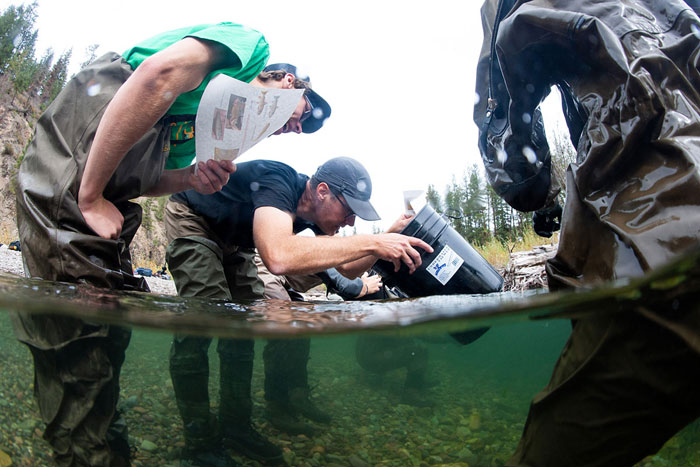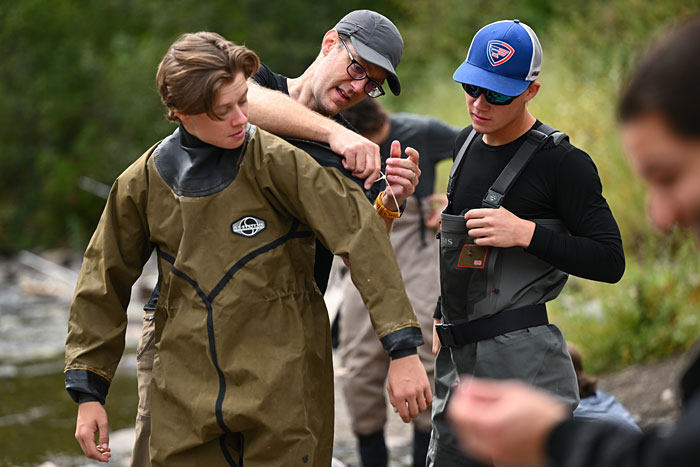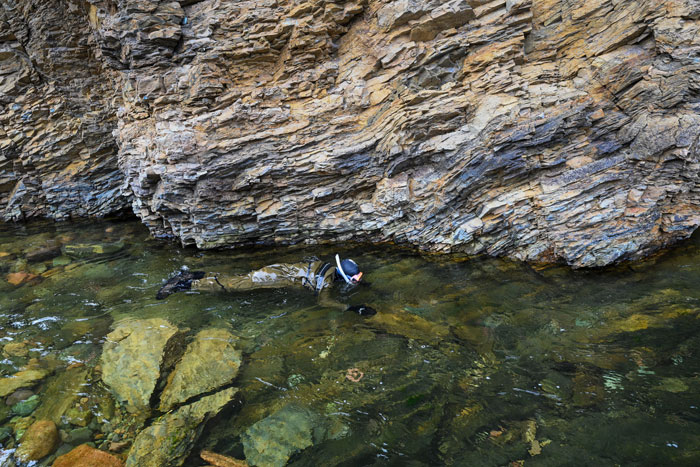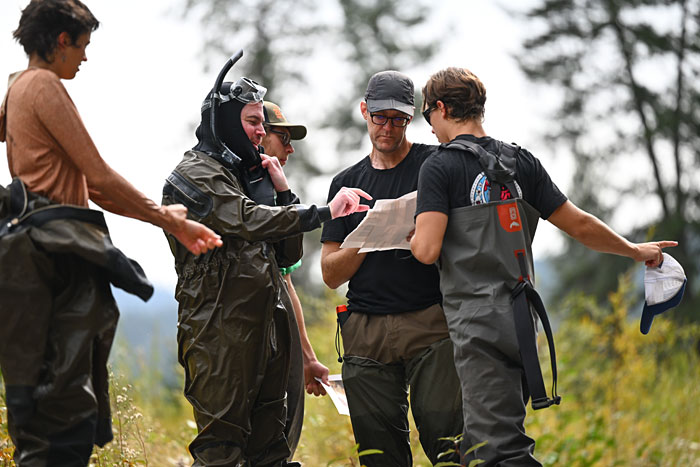UM Leads With Fisheries Education and Research

By Emily Senkosky and Elizabeth Harrison
UM News Service
MISSOULA – Whether it’s strapping into wetsuits to snorkel for data or bringing the lab streamside to sample fish, the University of Montana’s Fisheries Techniques class goes beyond classroom curriculum to get students hooked on the real-world applications of fisheries conservation and management.

Led by Andrew Whiteley, an associate professor of fisheries and conservation genomics in the W.A. Franke College of Forestry and Conservation, the class provides second-year students with opportunities to dive into the science of fisheries, literally. With fieldwork that includes snorkeling in the Blackfoot River Basin and Gold Creek, students can immerse themselves in learning while making meaningful contributions to the conservation of Montana’s aquatic ecosystems.
Whiteley’s vision is to empower students to address pressing issues facing fish in Montana and the wider Western region. Going beyond conventional learning, the class equips them with the skills and knowledge needed to tackle real-world challenges being seen in fisheries.
“At the heart of our class is the idea of applied management and conservation,” Whiteley said. “We discuss the big fisheries issues in the state, such as fragmentation of river and stream habitat and the influence of non-native fishes. We then learn about techniques and concepts fisheries biologists and researchers are using to inform data-driven solutions.”
Fisheries conservation and management is a high priority for a state where a staggering 1 million anglers travel to fish in its rivers and streams. The Fisheries Techniques class is just one of the ways the University is leading the charge in innovative research and education in fisheries management in the Western United States.
UM has been on the forefront of fisheries genetics research since the early 1970s, when Fred Allendorf, UM Regents Professor Emeritus of Biology, along with Robb Leary, a former UM biology professor, established one of the nation's inaugural fish genetics laboratories.
Recognizing the potential of this burgeoning field, Montana Fish, Wildlife and Parks partnered with Allendorf and Leary on a statewide genetic survey of Montana’s native trout populations. This collaboration has resulted in the creation of one of the world’s most comprehensive databases on native trout.
Whitelely arrived at UM a few decades later, obtaining his Ph.D. in organismal biology and ecology in 2005. After a few years in the field, he fulfilled his dream of returning to UM in 2016.
Whiteley’s own research works on habitat fragmentation and the dynamics between native and non-native fish populations in dammed river systems. In 2017, he secured $800,000 from the National Science Foundation to conduct a five-year study on small populations of trout and whether genetic rescue – strategic relocation of fish to restore small and isolated populations – works as a tool for conservation. This award was a CAREER grant from NSF, the most prestigious award offered to junior faculty and is limited to only a handful of assistant professors each year.
Whiteley said he feels privileged to continue the legacy left by Allendorf and Leary as principal investigator of the Montana Conservation Genomics Lab. Ryan Kovach, the State of Montana fisheries geneticist, is housed at the UM lab, which continues to play a pivotal role in most decisions made by Montana Fish, Wildlife and Parks in the realm of fisheries management.
“That’s somewhat unusual,” Whiteley said. “You can find states where it’s incorporated, but there are a ton of states where it’s not used nearly to the same extent. We are towards the top. I credit that to the longstanding relationship and trust-building Fred and Robb built with FWP.”

In both the field and the classroom, Whiteley’s students are actively involved in research aimed at informing the management of trout species by the state. They are at the forefront of addressing critical questions in conservation genomics, evolutionary biology and ecology – all geared towards maintaining healthy fish populations in Montana.
Collaborating closely with MFWP’s state fish geneticist and research scientists, Whiteley’s team furnishes genetic and genomics data, analyses and decision support pertaining to various species, including westslope cutthroat trout, Yellowstone cutthroat trout, bull trout, Arctic grayling and more.
“Our collaboration with MFWP and other agencies is instrumental in informing fisheries’ management decisions," Whiteley said. “We analyze thousands of samples annually, and the partnership underscores our commitment to preserving Montana's native fish and their habitats.”
The students’ contributions extend beyond Montana, providing valuable data and research to entities such as the U.S. Fish and Wildlife Service, the New Mexico Department of Game and Fish, and Colorado Parks and Wildlife.
Undergraduate student Max Posey, now a senior majoring in the terrestrial track of wildlife biology, took the Fisheries Techniques class in fall of 2021. He describes a fieldtrip where he witnessed electrofishing – a nonlethal method of gathering fish data – for the first time.

The process involves a small crew of three or four students who hike to a stream with a backpack that can produce small and controllable electrical output. Wading into the stream, the students then direct electrical probes to temporarily stun fish so they can net them and collect data from each fish. Through this practical application, students can accurately collect demographic information on the fish such as species and size range, which ultimately provides estimates of populations in a stream.
“The two most essential things I got from the class were that this type of work is enjoyable and applicable,” Posey said. “It’s as hands-on as it gets, and you’re able to gather a lot of really important data in the process.”
For Posey, the journey from the classroom to the stream was enough to get him officially committed to fisheries management. He worked for Nevada’s Department of Wildlife the following summer and believes he was chosen for the position because of the Fisheries Techniques class. He now plans to become a fisheries biologist and hopes to continue working with Whiteley in UM’s graduate school.
Classes led by Whiteley are meant to expose students to fun field work that helps them understand the key challenges now impacting Montana's aquatic ecosystems. His hope is to prepare students like Posey for future careers in biology while also instilling a deep sense of stewardship for Montana's natural resources.
Passion stirred up by the class is already having ripple effects, as one student expressed following a snorkeling field trip:
“This is exactly what I thought I would do when I came to Montana.”
###
Contact: Elizabeth Harrison, director of communications, W.A. Franke College of Forestry & Conservation, 917-656-9773, elizabeth.harrison@mso.umt.edu.
